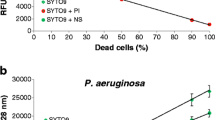Abstract
Currently, one of the most challenged points to expand the use of viability PCR technique is achieving the complete exclusion of dead cells amplification signals, thus avoiding the overestimation of live cells population. Considering that, and based on the hypothesis that DNA may be retained by microtube walls, the impact of the microtube was addressed on signals from live and heat-killed cells. A double-dye reagent, PEMAX™, which comprises a mix of photo-reactive azide forms of phenanthridium, was used in this work. We found that if both the incubation and the photoactivation steps are carried out in different microtubes, the dead cell signal is greatly reduced than when those steps are done in the same tube. Therefore, the strategy depicted in this study presents a simple and efficient step in minimizing false-positive signal when employing viability PCR.


Similar content being viewed by others
References
Barbau-Piedmoir E, Mahillon J, Pillyser J, Coucke W, Roosens N, Botteldoorn N (2014) Evaluation of viability-qPCR detection system on viable and dead Salmonella serovar Enteritidis. J Microbiol Methods 103:131–137
Belotserkovskii BP, Johnston BH (1997) Denaturation and association of DNA sequences by certain polypropylene surfaces. Anal Biochem 251:251–262
Cheng CM, Lin W, Van KT, Phan L, Tran NN, Farmers D (2008) Rapid detection of Salmonella in foods using real-time PCR. J Food Prot 71:2436–2441
Codony F, Agustí G, Allué-Guardia A (2015) Cell membrane integrity and distinguishing between metabolically active and inactive cells as a means of improving viability PCR. Mol Cell Probes 29:190–192
Elizaquivel P, Azizkhani M, Sánchez G, Aznar R (2013) Evaluation of Zataria multiflora Boiss essential oil activity against Escherichia coli O157:H7, Salmonella enterica and Listeria monocytogenes by propidium monoazide quantitative PCR in vegetables. Food Control 34:770–776
Fittipaldi M, Nocker A, Codony F (2012) Progress in understanding preferential detection of live cells using viability dyes in combination with DNA amplification. J Microbiol Methods 91:276–289
Gailard C, Strauss F (1998) Avoiding adsorption of DNA to polypropylene tube and denaturation of short DNA fragments. TechTips Online 3:63–65
GenIUL Technical Note (45000146-00) (2016) Understanding the tube contribution in vPCR results. Research Gate – Research. doi:10.13140/RG.2.1.4109.2722
Li B, Chen J (2013) Development of a sensitive and specific qPCR assay in conjunction with propidium monoazide for enhanced detection of live Salmonella spp. in food. BMC Microbiol 13:273
Liang N, Dong J, Luo L, Li Y (2012) Detection of viable Salmonella in lettuce by propidium monoazide real-time PCR. J Food Sci 76:234–237
Martin B, Raurich S, Garriga M, Aymerich T (2013) Effect of amplicon length in propidium monoazide quantitative PCR for the enumeration of viable cells of Salmonella in cooked ham. Food Anal. Methods 6:683–690
Moreno L, Aznar R, Sánchez G (2015) Application of viability PCR to discriminate the infectivity of hepatitis A virus in food samples. Int J Food Microbiol 201:1–6
Nkuipou-Kenfack E, Engel H, Fakih S, Nocker A (2013) Improving efficiency of viability-PCR for selective detection of live cells. J Microbiol Methods 93:20–24
Nocker A, Camper AK (2006) Selective removal of DNA from dead cells of mixed bacterial communities by use of Ethidium monoazide. Appl Environ Microbiol 72:1997–2004
Nocker A, Camper AK (2009) Novel approaches toward preferential detection of viable cells using nucleic acid amplification technique. FEMS Microbiol Lett 291:137–142
Singh G, Vajpayee P, Bhatti S, Ronnie N, Shah N, McClure P, Shanker R (2013) Determination of viable Salmonellae from potable and source water through PMA assisted qPCR. Ecotoxicol Environ Saf 93:121–127
Xiao L, Zhang Z, Sun X, Pan Y, Zhao Y (2015) Development of a quantitative real-time PCR assay for viable Salmonella spp. without enrichment. Food Control 57:185–189
Acknowledgements
The Authors thank Dr S. Duvenage from the Department of Plant and Soil Sciences, University of Pretoria, for the kind English review.
Author information
Authors and Affiliations
Corresponding author
Rights and permissions
About this article
Cite this article
Agustí, G., Fittipaldi, M. & Codony, F. False-Positive Viability PCR Results: An Association with Microtubes. Curr Microbiol 74, 377–380 (2017). https://doi.org/10.1007/s00284-016-1189-3
Received:
Accepted:
Published:
Issue Date:
DOI: https://doi.org/10.1007/s00284-016-1189-3




